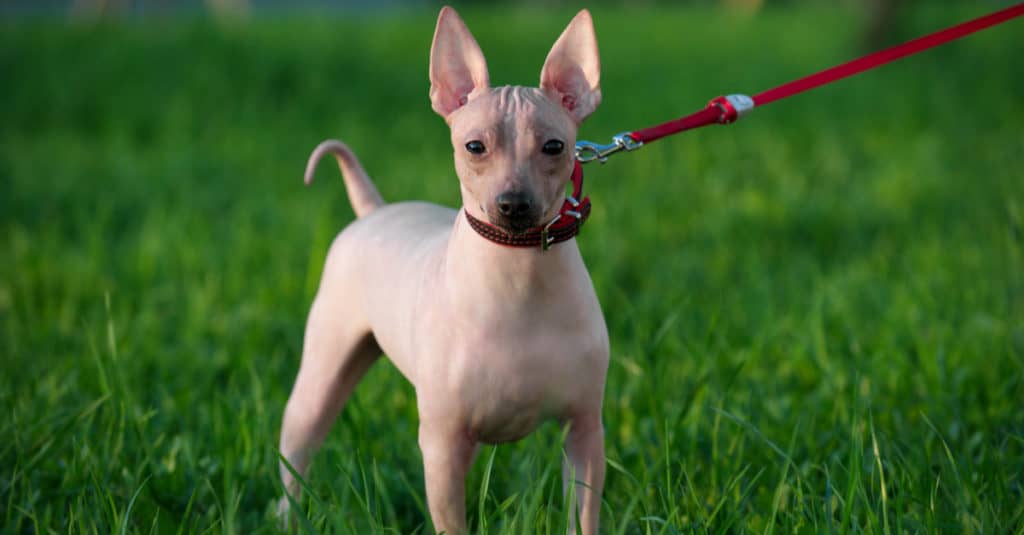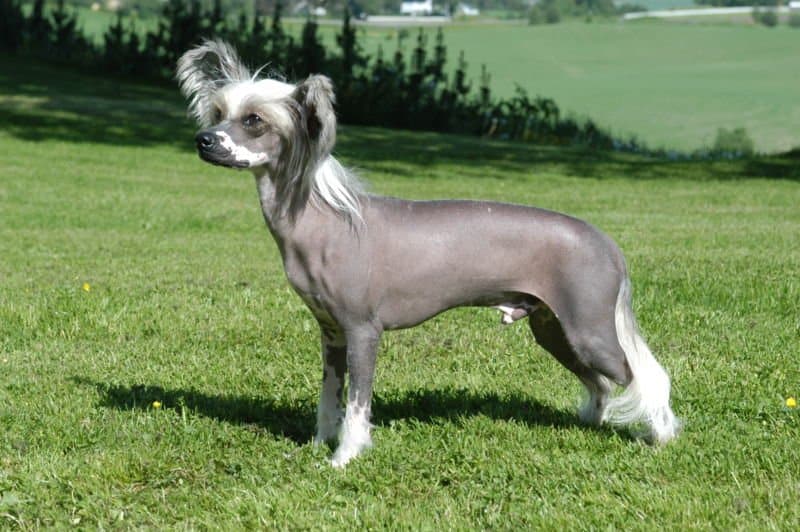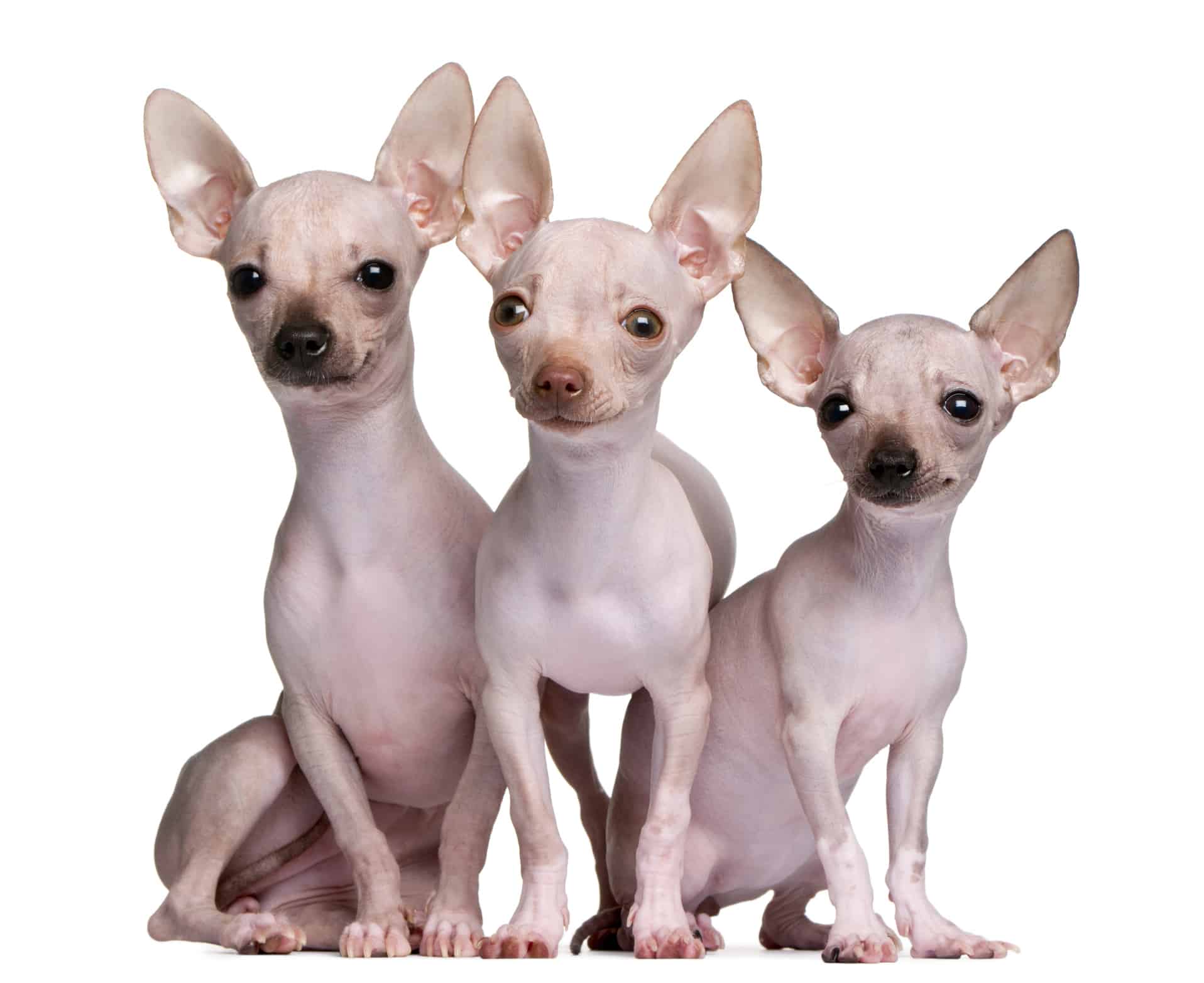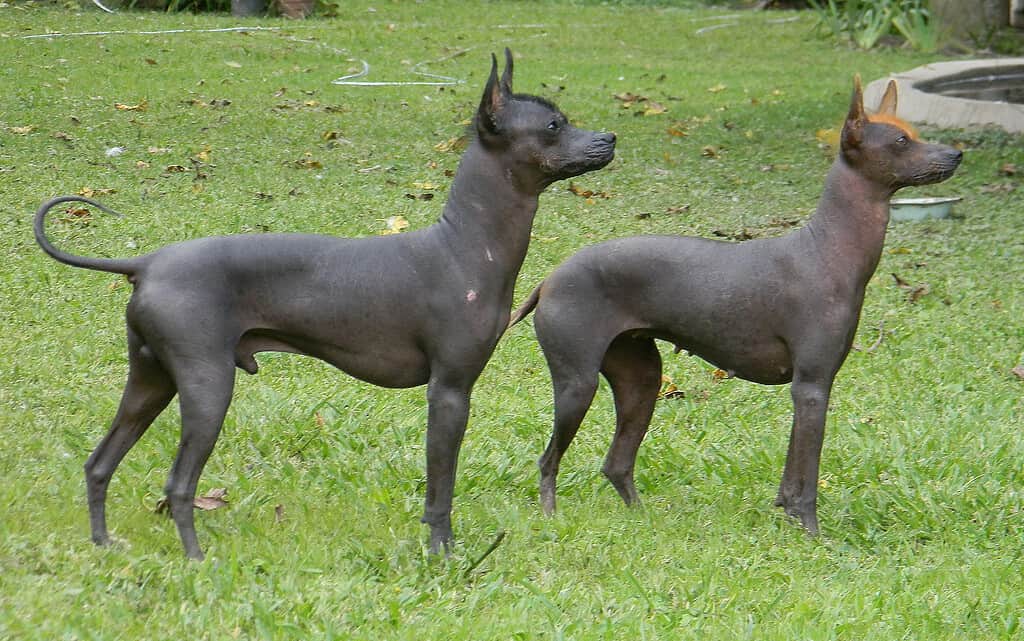If you’re looking for a pup who will stand out from the crowd, then a hairless dog breed might be the perfect pet for you! Although they require unique care and maintenance, hairless dog breeds can be excellent companions and family dogs. Plus, you don’t have to worry about brushing their coats or vacuuming up fur all over your house. And since they lack hair, many of these dogs are especially good cuddlers and love snuggling with their humans to keep warm. So, let’s take a closer look at 10 of these incredible hairless dog breeds!
Caring for Hairless Dog Breeds
Fortunately, you don’t have to worry about brushing hairless dogs, due to their lack of hair. However, without fur to protect them, hairless dogs are prone to developing skin problems. Most hairless breeds need protection from the sun (such as pet-safe sunscreen and protective clothing), as well as from rain and cold. In addition, while many hairless dog breeds are great for people with allergies, some owners still react to them due to the dog’s saliva and dander.
Hairless dogs also have skin that is often more sensitive to outdoor plants, as well as indoor textures and even lotions and perfumes humans wear. They also need regular baths to keep their pores free from dirt and infection, as well as extra moisturizing to keep their skin from drying out. Researching the type of hairless dog and their unique needs is the key to giving them a long, healthy, and happy life. So, what types of hairless dog breeds are out there? Let’s take a look!
1. American Hairless Terrier
History: Originating in Louisiana, the American hairless terrier is descended from the rat terrier dog breed. When a hairless rat terrier was born in the 1970s, its owners began selectively breeding to create a new hairless dog breed.
Appearance: American hairless terriers come in a wide variety of different colors, from black, white, and chocolate to apricot, blue, red, and lilac. They can also have a mix of colors, such as white and black, white and apricot, pink and grey, etc. American hairless terriers have small, muscular bodies, and while most of the time they are hairless, occasionally some dogs are born with a very short and fine coat of hair.
Personality and Behavior: American hairless terriers have the spunk and energy of a typical terrier, as well as a high prey drive when it comes to small rodents. These dogs are very smart and love to play, and they make great family pets.
- Height: 12 to 16 inches
- Weight: 12 to 16 pounds
- Life Expectancy: 14 to 16 years

American hairless terriers come in a wide variety of different colors, from black, white, and chocolate to apricot, blue, red, and lilac.
©art nick/Shutterstock.com
2. Chinese Crested
History: Although it is technically called the Chinese crested, this dog did not originate from China. In fact, it is likely that the Chinese crested dog breed evolved from African hairless dogs and then was bred into a smaller breed by the Chinese. For centuries sailors from China traveled with these dogs on their ships and often traded them with local merchants. Chinese crested dogs were even found by Spanish explorers in Central and South America in the 1500s.
Appearance: The Chinese crested dog breed is one of the most unique-looking hairless dogs. Although their main body is completely hairless, these dogs also have feathery or spiky tufts of hair on their tails, paws, and heads. This breed comes in two different varieties, both of which can be born in the exact same litter: hairless and powderpuff. Hairless Chinese crested dogs typically do not have much fur on their heads, tails, or paws, although some may also have hair on their snouts as well. Their fur is a single coat and usually very thin and fine. Powderpuff Chinese crested dogs, on the other hand, have a double coat of fur that is long, soft, and silky. Both varieties come in many different colors, such as palomino, pink and grey, black, chocolate, white, and apricot.
Personality and Behavior: Chinese crested dogs are very active animals with small and slender bodies. Despite their wispy and delicate appearance, these pint-sized pups have a remarkable tenacity and drive, and can be great competitors in canine sporting events. They have spunky personalities and love to be outside. However, as a hairless breed, Chinese crested dogs need protective clothing and pet-safe sunscreen when playing outdoors.
- Height: 11 to 13 inches
- Weight: 8 to 12 pounds
- Life Expectancy: 13 to 18 years

Although their main body is completely hairless, Chinese crested dogs have feathery or spiky tufts of hair on their tails, paws, and heads.
3. Xoloitzcuintli (Xolo)
History: Also known as the Mexican hairless, the Xoloitzcuintli (pronounced “show-low-eats-QUEENT-lee”) is another very old dog breed that goes back 3,000 years to the ancient Aztec empire. Its name comes from the Aztec god of lightning and fire, Xolotl, and the Nahuatl word itzcuīntli, which means dog.
Appearance: These dogs are muscular, with wrinkly foreheads and graceful bodies that can be hairless or coated. Hairless Xolos have smooth, tight skin, while coated Xolos have a short and flat coat of hair. Both types come in a variety of dark colors, from black and gray to bronze, red, or liver.
Personality and Behavior: Although they are rugged, muscular dogs and require plenty of exercise and playtime, Xolos are surprisingly calm and peaceful around the house. Like other hairless breeds, Xolos are prone to sun damage and need pet-safe sunscreen if they are going to be out in the sun for long periods of time. In addition, younger dogs often have more sensitive skin and can develop adolescent acne. Xolos are extremely loyal and make excellent watchdogs. They only bark when they feel it is necessary, and thrive off of consistent training and clear boundaries. They are incredibly loving and affectionate dogs and like spending time with their families.
- Height: 10 to 14 inches (toy); 14 to 18 inches (miniature); 18 to 23 inches (standard)
- Weight: 10 to 15 pounds (toy); 15 to 30 pounds (miniature); 30 to 55 pounds (standard)
- Life Expectancy: 13 to 18 years

Hairless Xolos have smooth, tight skin, while coated Xolos have a short and flat coat of hair.
©art nick/Shutterstock.com
4. Hairless Chihuahua
History: A hairless chihuahua certainly looks unique, but in reality, these smooth-skinned pups are just regular chihuahuas in disguise! In other words, technically a hairless chihuahua is not its own separate breed. The dogs’ lack of hair is due to a genetic mutation — so these dogs are simply regular chihuahuas without any hair. The chihuahua is a national symbol of Mexico, with a personality that far exceeds its size. Believed to date back to pre-Columbian times, these tiny dogs are one of the oldest breeds of the Americas.
Appearance: Some dogs are completely hairless, while others are only partially hairless, with bald spots or tufts of hair in various places on their bodies. Hairless chihuahuas come in many different colors, like black, red, cream, chocolate, or a mix of different colors. Like other chihuahuas, they have small bodies with large eyes and tall, pointy ears.
Personality and Behavior: These dogs have been loyal companions to families throughout history, with happy and sassy personalities. Unlike regular chihuahuas, however, hairless chihuahuas are much more vulnerable to sunburn and cold weather and require special attention to keep them safe and healthy. In general, hairless chihuahuas are almost always cold and are susceptible to hypothermia. When going outside, they need pet-safe sunscreen due to their exposed skin, and they have a much higher risk of developing skin cancer.
- Height: 5 to 8 inches
- Weight: Usually not more than 6 pounds
- Life Expectancy: 14 to 16 years

A hairless chihuahua is a regular chihuahua without hair due to a genetic mutation.
©iStock.com/GlobalP
5. Peruvian Inca Orchid
History: The Peruvian Inca orchid is a hairless dog breed that comes from ancient Peru. It is also called the Peruvian hairless, and it was mostly kept as a companion animal. Although these dogs were kept during the Incan Empire, their heritage actually goes back much further in history to pre-Inca cultures. There are even depictions of these dogs that are as old as A.D. 750!
Appearance: Peruvian Inca orchid dogs have lean, long bodies with low tails and pointy ears. There are both coated and hairless varieties that come in many colors, like white, tan, black, gray, brown, or pink. Some may even have pink spots. Hairless types have smooth skin without any hair, due to a dominant double lethal mutation. This means that the dog’s DNA has two copies of the same gene, but both cannot exist at the same time. When this happens, it prevents any babies with two copies of the gene from being born. That’s why you usually see twice as many hairless dogs as coated ones. Some Peruvian Inca orchids also have tufts of hair on top of their heads, paws, or tips of their tails.
Personality and Behavior: Peruvian Inca orchids are excellent watchdogs and are extremely protective of their families. They often suffer from separation anxiety, are wary around strangers, and require plenty of mental enrichment. Peruvian Inca orchid dogs need regular baths to get rid of dirt and keep their pores from clogging. Some dogs might even get blackheads, acne, and dry skin. Extra care is needed around the edges of their ears to keep them from becoming too dried out or cracked.
- Height: 9.75 to 15.75 inches (small); 15.75 to 19.85 inches (medium); 19.75 to 25.75 inches (large)
- Weight: 8.5 to 17.5 pounds (small); 17.5 to 26.5 pounds (medium); 26.5 to 55 pounds (large)
- Life Expectancy: 12 to 14 years

Peruvian Inca orchid dogs have lean, long bodies with low tails and pointy ears.
©Vera Reva/Shutterstock.com
6. Ecuadorian Hairless Dog
History: Likely a descendant of the Peruvian Inca orchid dog, the Ecuadorian hairless dog is one of the rarest types of hairless breeds in the world. This ancient breed comes from Ecuador and has little to no hair on its body, except for a small amount on top of its head.
Appearance: These dogs have long legs, elegant bodies, and short tails. Eucaudorian hairless dogs have greyish-brown skin and the little hair that remains on top of their heads is a slightly reddish color. However, depending on how much hair remains, it can look much lighter. The fur here is extremely short and usually splotchy or randomly dispersed. Another interesting characteristic of these dogs is that if you see one during a sunset, their skin reflects the sun and appears golden.
Personality and Behavior: You will not see this unique dog competing at any official breed events, as it is not considered an officially registered breed. Instead, many considered it a descendant and subtype of the Peruvian Inca orchid dog. Although Ecuadorian hairless dogs have been around for a very long time, during the 5th and 5th centuries, their numbers plummeted due to war, cruelty, hunger, and disease, and they were restricted to the Gulf of Guayaquil. These dogs are excellent hunters and affectionate companions.
- Height: 15 to 18 inches
- Weight: 17 to 25 pounds
- Life Expectancy: 12 to 14 years
7. Argentina Pila Dog
History: Another close relative of the Peruvian Inca orchid dog, the Argentina pila dog is a rare hairless breed that is mostly found in its native homeland of Argentina. These dogs have been recorded living in Buenos Aires in the 1400s, but there is also evidence that suggests that pilas have been around for much longer. In fact, it’s thought that the Argentina pila dog came from the Incan Empire over 3,000 years ago as a gift to strengthen the bonds between the two cultures.
Appearance: Argentina pilas come in three sizes and have relatively short bodies, curled tails, and narrow muzzles. Most of the time they are hairless, but some dogs will also have some hair on top of their heads and on their tails. There can be both hairless and coated pups in the same litter. They come in a variety of colors, and may be spotted, mottled, or have piebald markings.
Personality and Behavior: These dogs are playful and loving, and adapt quickly and easily. They have affectionate and lively personalities and are also great guard dogs. One of their most prized features is their incredibly soft skin. However, since they have little to no hair, these dogs need extra special care to keep that soft skin healthy.
- Height: 10 to 14 inches (small); 14 to 18 inches (medium); 18 to 25 inches (large)
- Weight: 9 to 18 pounds (small); 18 to 25 pounds (medium); 25 to 55 pounds (large)
- Life Expectancy: 8 to 14 years

Argentine Pila dogs are one of the South American hairless dog breeds, which were once considered a single breed.
©Monica S. Cassels / CC BY-SA 3.0 – License
8. Abyssinian Sand Terrier
History: Also referred to as the African hairless dog, the Abyssinian sand terrier is a rare type of hairless dog breed that originated somewhere in Africa. It is unknown how many of these dogs still exist today, as they are so rare and seldom recorded.
Appearance: These dogs have sleek bodies that are small to medium in size, with long muzzles and bat-like ears. Some Abyssinian sand terriers are completely hairless, while others may have small tufts of fur on the tips of their tails or on top of their heads. These dogs can be grey, sand, black, or bronze in color, and their skin sometimes has mottled markings.
Personality and Behavior: Abyssinian sand terriers are courageous companions that fiercely protect their owners and homes. They are loyal and affectionate with their humans, and willing to please. They make great exercise companions, but at home, they usually have a quiet and calm demeanor.
- Height: 15.5 to 20.5 inches
- Weight: 21 to 39 pounds
- Life Expectancy: 12 to 15 years

Abyssinian sand terriers are also called African hairless dogs.
©iStock.com/LindasPhotography
9. Hairless Khala
History: Also called Bolivian hairless dogs, hairless khalas are a rare dog breed that originated in Bolivia.
Appearance: These dogs have dark gray skin, with white tufts of hair on their heads. They come in two sizes, and some dogs have short legs while others have much longer ones. Hairless khalas are powerful dogs that are agile and graceful. Most dogs are dark gray, but there are sometimes variations in color.
Personality and Behavior: These dogs need daily walks and plenty of exercise, and are prone to chase without hesitation. Hairless khalas often form close relationships with other dogs, and it’s best to have two dogs in the home to keep each other company. Khalas can be shy around strangers and need help with socialization when they are young. However, they are very loving and gentle with people they know and are usually good with other animals in their homes. They make great family pets and are not aggressive. In fact, these dogs are not fans of confrontation, and often walk or run away from potential threats. They require special attention and care for their hairless bodies, such as pet-safe sunscreen and protective clothing during cold weather.
- Height: 14 to 17 inches (medium); 17 to 20 inches (large)
- Weight: 15 to 30 pounds (medium); 18 to 30 pounds (large)
- Life Expectancy: 12 to 15 years
10. Jonangi
History: Last but not least, we have the Jonangi, a hairless dog breed from India. This is a rare breed today and was originally bred as a hunting and herding dog. Although they were once quite common throughout India’s coastal region, farmers don’t use them as frequently as they used to, and many dogs were left to fend for themselves in semi-feral conditions. Some of these dogs have developed a rather unique hunting technique, learning how to fish for themselves!
Appearance: Although they are typically hairless, there are also many Jonangi that have smooth, short coats that are hard to see. They come in black, chocolate, white, brindle, grey, and fawn, and often have piebald or spotted markings. Jonangi dogs have muscular bodies with short muzzles, wrinkled foreheads, pricked ears, and curled tails.
Personality and Behavior: Another incredibly unique feature of these dogs is that they do not bark — instead, Jonangis yodel! While they tend to be wary around strangers, Jonangis are extremely loving and friendly toward their families, including children, other pets, and even farm animals. With proper socialization and training through positive reinforcement, these dogs turn into confident adults and loving companions.
- Height: 18 to 22 inches
- Weight: 45 to 85 pounds
- Life Expectancy: 10 to 14 years
Summary of the 10 Hairless Dog Breeds
Here is a list of the 10 Hairless Dog Breeds:
| Rank | Dog Breeds |
|---|---|
| 1 | American Hairless Terrier |
| 2 | Chinese Crested |
| 3 | Xoloitzcuintli (Xolo) |
| 4 | Hairless Chihuahua |
| 5 | Peruvian Inca Orchid |
| 6 | Ecuadorian Hairless Dog |
| 7 | Argentina Pila Dog |
| 8 | Abyssinian Sand Terrier |
| 9 | Hairless Khala |
| 10 | Jonangi |
The photo featured at the top of this post is © Martyna Nysk/Shutterstock.com
Ready to discover the top 10 cutest dog breeds in the entire world?
How about the fastest dogs, the largest dogs and those that are -- quite frankly -- just the kindest dogs on the planet? Each day, AZ Animals sends out lists just like this to our thousands of email subscribers. And the best part? It's FREE. Join today by entering your email below.
FAQs (Frequently Asked Questions)
What causes a dog to be hairless?
Hairless dogs lack hair due to their genetic makeup. Sometimes dogs are just born that way, while other times breeders selectively breed for hairless dogs types.
Are hairless dogs hypoallergenic?
While a hairless dog breed can be a great choice for someone who suffers from allergies, they are not entirely hypoallergenic. Dog and cat allergies in humans are often reactions to the animal’s saliva and dander, not just their fur.
How do you care for a hairless dog?
Fur acts as an important protective barrier against the elements. It works as a shield against rain, sun, heat, cold, and other irritating substances. However, hairless dogs do not have this protection. That means that they need extra help to keep them safe and healthy.
Hairless dog breeds need regular bathing, along with special creams and moisturizers designed for dogs. In hot weather, they may need cooling vests, while in cold weather they may need warm coats. In addition, many hairless dog breeds also need pet-safe sunscreen and/or protective clothing to keep their skin safe from the sun. Just like humans, hairless dogs are prone to developing skin cancer from the damaging rays of the sun.
Thank you for reading! Have some feedback for us? Contact the AZ Animals editorial team.






